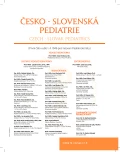Care for children with haemophilia in the Czech Republic
Authors:
J. Blatný; P. Ovesná
Authors‘ workplace:
Institut biostatistiky a analýz, Lékařská fakulta Masarykovy univerzity, Brno
; Oddělení dětské hematologie, FN Brno a Lékařská fakulta Masarykovy univerzity, Brno
Published in:
Čes-slov Pediat 2017; 72 (3): 148-153.
Category:
Overview
Haemophilia is rare, though severe disease. Significant improvements in care of haemophilia since second half of 20th century changed it from the deadly disease to the well-controlled condition. In the Czech Republic, haemophilia care is overseen and guaranteed by the Czech National Haemophilia Programme (CNHP) – an association of all haemophilia treatment centres in the country.
Haemophilia treatment is complex and multidisciplinary. CNHP runs the registry recording all relevant data concerning haemophilia treatment nation-wide. There were 246 children with haemophilia registered in the Czech Republic in 2015. With the treatment provided, their median annual bleeding rate was three even for those with severe disease. All children are offered home therapy, and all, who need it, are on prophylaxis. No child has been infected with HIV or HCV viruses. Children with inhibitors are offered immune-tolerance treatment. Though the treatment of haemophilia in children is effective and safe in these days in the Czech Republic, risks associated with the disease should not be underestimated.
Key words:
haemophilia, inhibitors, bleeding, prophylaxis
Sources
1. Oldenburg J. Optimal treatment strategies for hemophilia: achievements and limitations of current prophylactic regimens. Blood 2015; 125 (13): 2038–2044.
2. Gringeri A, Ewenstein B, Reiniger A. The burden of bleeding in haemophilia: is one bleed too many? Haemophilia 2014; 20 (4): 459–463.
3. Blanchette VS, Schrivastava A. Definitions in hemophilia: resolved and unresolved issues. Semin Thromb Hemost 2015; 41 (8): 819–825.
4. Nilsson IM, Blombäck M, Ahlberg A. Our experience in Sweden with prophylaxis on haemophilia. Bibl Haematol 1970; 34: 111–124.
5. Manco-Johnson MJ, et al. Prophylaxis versus episodic treatment to prevent joint disease in boys with severe hemophilia. N Engl J Med 2007; 357 (6): 535–544.
6. Gringeri A, et al. Tertiary prophylaxis in adults: is there a rationale? Haemophilia 2012; 18 (5): 722–728.
7. Blanchette VS, Schrivastava A. Definitions in hemophilia: resolved and unresolved issues. Semin Thromb Hemost 2015; 41 (8): 819–825.
8. Haya S, et al. Inhibitors in haemophilia A: current management and open issues. Haemophilia 2007; 13 (Suppl 5): 52–60.
9. Blatný J, et al. Inhibitors incidence rate in Czech previously untreated patients with haemophilia A has not increased since introduction of recombinant factor VIII treatment in 2003. Blood Coagul Fibrinolysis 2015; 26 (6): 673–678.
10. Fischer K, Blatny J. Do the SIPPET study results apply to the patients I treat Haemophilia 2016; in press.
11. Rocino A, et al. Immune tolerance induction in patients with haemophilia a and inhibitors: effectiveness and cost analysis in an European Cohort (The ITER Study). Haemophilia 2016; 22 (1): 96–102.
12. De Kleijn P, Heijnen L, Van Meeteren NL. Clinimetric instruments to assess functional health status in patients with haemophilia: a literature review. Haemophilia 2002; 8 (3): 419–427.
13. Feldman BM, et al. The Haemophilia Joint Health Score (HJHS) international validation study. XXVIIIth International Congress of the World Federation of Hemophilia, Istanbul, Turkey. Haemophilia 2008; 14 (Suppl 2): 83.
14. Lundin B, et al. An MRI scale for assessment of haemophilic arthropathy from the International Prophylaxis Study Group. Haemophilia 2012; 18: 962–970.
15. von Mackensen S, et al. Measurement properties of the Haem-A-QoL in haemophilia clinical trials. Haemophilia 2016; in press.
16. Smejkal P, et al. Konsenzuální doporučení Českého národního hemofilického programu (ČNHP) pro diagnostiku a léčbu pacientů s vrozenou hemofilií a s inhibitorem FVIII/FIX. Transfuze Hematol dnes 2016; 22 (1): 44–54.
17. Hrdličková R, et al. Konsenzuální doporučení českého národního hemofilického programu (ČNHP) pro zajištění chirurgických a invazivních výkonů u pacientů s hemofilií. Transfuze Hematol dnes 2016; 22 (1): 39–43.
18. Smejkal P, et al. Diagnostika a léčba hemofilie. Transfuze Hematol dnes 2013, 19 (2): 100–114.
19. Svensson PJ, et al. Desmopressin in treatment of haematological disorders and in prevention of surgical bleeding. Blood Rev 2014; 28 (3): 95–102.
20. Kurnik K, Auerwald G, Kreuz W. Inhibitors and prophylaxis in paediatric haemophilia patients: focus on the German experience. Thromb Res 2014; 134 (Suppl 1): S27–32.
21. Blatný J, et al. Farmakokinetika jako nástroj k optimalizaci léčby osob s hemofilií. Transfuze Hematol dnes 2014; 20 (4): 103–106.
22. Colvin B, et al. European principles of haemophilia care. Haemophilia 2008; 14 (2): 361–374.
23. Peyvandi F, Gargiola I, Biguzzi E. Advances in the treatment of bleeding disorders. J Thromb Haemost 2016; 14 (11): 2095–2106.
Labels
Haematology Neonatology Paediatrics General practitioner for children and adolescentsArticle was published in
Czech-Slovak Pediatrics

2017 Issue 3
Most read in this issue
- Patello-femoral disorders in children
- Legg-Calve-Perthes disease
- Pepsin in secretion from the upper respiratory tract as a marker of extraesophageal reflux in children
- RSV infection in late preterm infants
